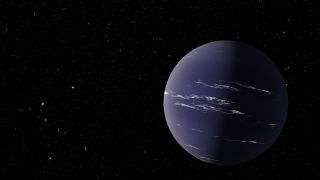Weird Neptune-like exoplanet may have water clouds
A Neptune-like planet that's relatively close to Earth may sport a watery surprise.

A Neptune-like planet that's relatively close to Earth may sport a watery surprise.
The exoplanet, called TOI-1231 b, might have clouds of water high in its atmosphere, but the observations are so preliminary that it's hard to say for sure.
"Future observations of this new planet will let us determine just how common (or rare) it is for water clouds to form around these temperate worlds," Jennifer Burt, a scientist at NASA's Jet Propulsion Laboratory in California and lead author of the new research, said in a statement from the University of New Mexico, which was also involved in the research.
Related: 10 extraordinary ocean worlds in our solar system in photos
While observations of TOI-1231 b suggest that the planet has a substantial atmosphere, the researchers cautioned that they can't quite figure out the planet's composition. Models suggest that it has either a dense water-vapor atmosphere, which could contain the water clouds, or a larger hydrogen or hydrogen-helium atmosphere similar to Neptune's.
The confirmations could come relatively quickly. TOI-1231 b is just 90 light-years from Earth, making it relatively easy to spot in large observatories. NASA's James Webb Space Telescope, which may launch this fall, is optimized to look at planets with atmospheres, especially gas giants.
But even before that, the team will get a crack at observations using the Hubble Space Telescope, because one of the paper's authors has telescope time booked on the 31-year-old observatory. (Those observations will depend on NASA solving a computer glitch that has sidelined Hubble since June 13.)
Get the Space.com Newsletter
Breaking space news, the latest updates on rocket launches, skywatching events and more!
"With a technique called transmission spectroscopy, scientists should be able to use the Hubble Space Telescope — and soon, the far more sensitive James Webb Space Telescope — to capture starlight shining through the atmosphere of TOI-1231 b," NASA said in a statement about the discovery. "Molecules in this planet's atmosphere will absorb slices of light from this spectrum, leaving dark lines that can be read like a barcode, revealing which gases are present."
Hubble will also look for evidence of a "tail" emanating from the planet, which would appear if atoms of hydrogen or helium were visible as the planet transited across the face of its star.
Usually, hydrogen atoms are really tough to spot because they are so similar to interstellar gas, the team said. In this case, however, the planet-star system is moving quite quickly away from Earth, and that speed allows an unusual opportunity to spot potentially zippier hydrogen atoms against the slower interstellar background.
We do know a few things about TOI-1231 b, which was detected by NASA's Transiting Exoplanet Survey Satellite (TESS) and confirmed using the Carnegie Planet Finder Spectrograph on the Magellan Clay Telescope in Chile. TOI-1231 b has a diameter roughly 3.5 times that of Earth, making it a bit smaller than Neptune. TOI-1231 b also has a 24-day orbital period, tugging in close to a nearby M dwarf star just 90 light-years from Earth.
Because M dwarfs are just a fraction of the size of Earth's sun, it's easier for telescopes to spot darkening as a large planet passes across a star's surface (as TESS did) or the gravitational "wobbles" induced during the planetary orbit (as the Magellan Clay Telescope observed).
Despite orbiting closely to its star, TOI-1231 b has a relatively cool atmosphere of 140 degrees Fahrenheit (60 degrees Celsius). While that's more than double Earth's average temperature, Burt said TOI-1231 b is "positively frigid" compared with most transiting planets, such as "hot Jupiters," which typically reach scorching temperatures in the hundreds or thousands of degrees Fahrenheit or Celsius.
A study based on the research will be published in The Astronomical Journal, and a preprint version of the paper is available in the arXiv database. You can also read more about TOI-1231 b in the NASA Exoplanet Archive.
Follow Elizabeth Howell on Twitter @howellspace. Follow us on Twitter @Spacedotcom and on Facebook.
Join our Space Forums to keep talking space on the latest missions, night sky and more! And if you have a news tip, correction or comment, let us know at: community@space.com.

Elizabeth Howell (she/her), Ph.D., is a staff writer in the spaceflight channel since 2022 covering diversity, education and gaming as well. She was contributing writer for Space.com for 10 years before joining full-time. Elizabeth's reporting includes multiple exclusives with the White House and Office of the Vice-President of the United States, an exclusive conversation with aspiring space tourist (and NSYNC bassist) Lance Bass, speaking several times with the International Space Station, witnessing five human spaceflight launches on two continents, flying parabolic, working inside a spacesuit, and participating in a simulated Mars mission. Her latest book, "Why Am I Taller?", is co-written with astronaut Dave Williams. Elizabeth holds a Ph.D. and M.Sc. in Space Studies from the University of North Dakota, a Bachelor of Journalism from Canada's Carleton University and a Bachelor of History from Canada's Athabasca University. Elizabeth is also a post-secondary instructor in communications and science at several institutions since 2015; her experience includes developing and teaching an astronomy course at Canada's Algonquin College (with Indigenous content as well) to more than 1,000 students since 2020. Elizabeth first got interested in space after watching the movie Apollo 13 in 1996, and still wants to be an astronaut someday. Mastodon: https://qoto.org/@howellspace
